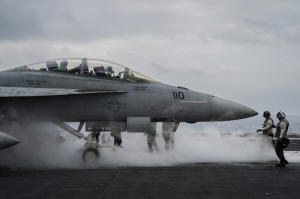The Atlantic releases the Signal chat showing Hegseth's detailed attack
plans against the Houthis
[March 27, 2025]
By TARA COPP
WASHINGTON (AP) — The Atlantic on Wednesday released the entire Signal
chat among senior national security officials, showing that Defense
Secretary Pete Hegseth provided the exact timings of warplane launches
and when bombs would drop — before the men and women flying those
attacks against Yemen’s Houthis this month on behalf of the United
States were airborne.
The disclosure follows two intense days during which leaders of
President Donald Trump's intelligence and defense agencies have
struggled to explain how details — that current and former U.S.
officials have said would have been classified — wound up on an
unclassified Signal chat that included Atlantic Editor-in-Chief Jeffrey
Goldberg,
White House press secretary Karoline Leavitt has said no classified
information was posted to the Signal chat.
Sen. Roger Wicker, R-Miss., chairman of the Senate Armed Services
Committee, said he and Rhode Island Sen. Jack Reed, the committee’s top
Democrat, plan to send a letter to the Trump administration requesting
an inspector general investigation into the use of Signal. They seek a
classified briefing with a top administration official “who can speak to
the facts” of the episode.
Top military official was not included in the chat
The chat was also notable for who it excluded: the only military
attendee of the principals committee, the chairman of the Joint Chiefs
of Staff.
Adm. Christopher Grady is currently serving in that position in an
acting capacity because Trump fired former chairman Gen. CQ Brown Jr. in
February.

National security adviser Mike Waltz was authorized to decide whether to
include the Joint Chiefs chairman in the principals committee
discussion, “based on the policy relevance of attendees to the issues
being considered, the need for secrecy on sensitive matters, staffing
needs, and other considerations,” the White House said in a Jan. 20
memo.
The Pentagon said it would not comment on the issue, and it was not
immediately clear why Grady, currently serving as the president’s top
military adviser, would not be included in a discussion on military
strikes.
Hegseth has refused to say whether he posted classified information onto
Signal. He is traveling in the Indo-Pacific and to date has only scoffed
at questions, saying he did not reveal “war plans.” Director of National
Intelligence Tulsi Gabbard and CIA Director John Ratcliffe told members
of the Senate Intelligence Committee on Tuesday that it was up to
Hegseth to determine whether the information he was posting was
classified or not.
Very specific texts were revealed
What was revealed was jaw-dropping in its specificity and includes the
type of information that is kept to a very close hold to protect the
operational security of a military strike. But Hegseth’s spokesman, Sean
Parnell, said in a statement Wednesday that “there were no classified
materials or war plans shared. The Secretary was merely updating the
group on a plan that was underway.”
The Pentagon and White House have tried to deflect criticism by
attacking Goldberg and The Atlantic. The magazine and Goldberg, however,
repeatedly reached out to the White House before and after publication
to gain additional context on the Signal chat and ensure that publishing
the full texts would not cause harm. In a response, Goldberg reported
Wednesday, Leavitt described some of the information as sensitive and
said the White House would prefer it not be published.
[to top of second column]
|

F/A-18F Super Hornet fighter jet takes off from the aircraft carrier
U.S.S. Dwight D. Eisenhower, also known as the 'IKE', in the south
Red Sea, Tuesday, Feb. 13, 2024. (AP Photo/Bernat Armangue, File)

In the group chat, Hegseth posted multiple details about the
impending strike, using military language and laying out when a
“strike window” starts, where a “target terrorist" was located, the
time elements around the attack and when various weapons and
aircraft would be used in the strike. He mentioned that the U.S. was
“currently clean” on operational security."
“Godspeed to our Warriors,” he wrote.
“1215et: F-18s LAUNCH (1st strike package)”
“1345: ‘Trigger Based’ F-18 1st Strike Window Starts (Target
Terrorist is @ his Known Location so SHOULD BE ON TIME – also,
Strike Drones Launch (MQ-9s)”
“1410: More F-18s LAUNCH (2nd strike package)”
“1415: Strike Drones on Target (THIS IS WHEN THE FIRST BOMBS WILL
DEFINITELY DROP, pending earlier ‘Trigger Based’ targets)”
“1536 F-18 2nd Strike Starts – also, first sea-based Tomahawks
launched.”
“MORE TO FOLLOW (per timeline)”
“We are currently clean on OPSEC” — that is, operational security.
A strike package includes the personnel and weapons used in an
attack, including Navy F-18 fighter aircraft. MQ-9s are armed
drones. Tomahawks are ship-launched cruise missiles.
Goldberg has said he asked the White House if it opposed publication
and that the White House responded that it would prefer he did not
publish.
Signal is encrypted but can be vulnerable
Signal is a publicly available app that provides encrypted
communications, but it can be hacked. It is not approved for
carrying classified information. On March 14, one day before the
strikes, the Defense Department cautioned personnel about the
vulnerability of Signal, specifically that Russia was attempting to
hack the app, according to a U.S. official who was not authorized to
discuss the matter publicly and spoke on the condition of anonymity.
One known vulnerability is that a malicious actor, with access to a
person’s phone, can link his or her device to the user’s Signal and
essentially monitor messages remotely in real time.

Leavitt is one of three Trump administration officials who face a
lawsuit from The Associated Press on First and Fifth Amendment
grounds. The AP says the three are punishing the news agency for
editorial decisions they oppose. The White House says the AP is not
following an executive order to refer to the Gulf of Mexico as the
Gulf of America.
—-
Associated Press writer Stephen Groves contributed to this report.
All contents © copyright 2025 Associated Press. All rights reserved |